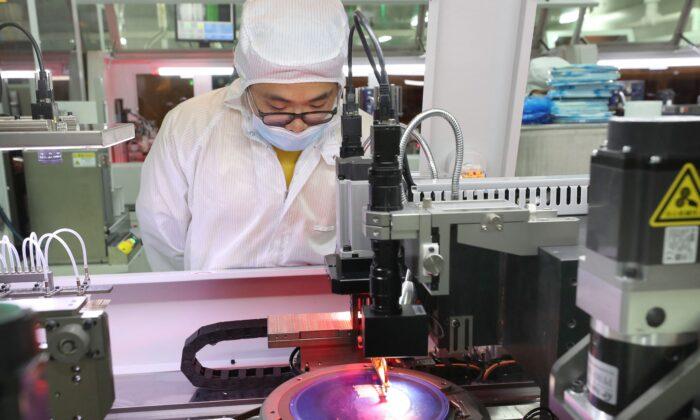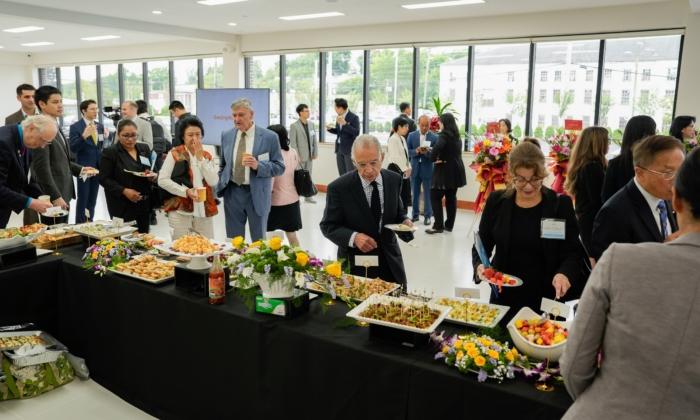Amid global chip shortages, China’s largest chipmaker—facing a U.S. blacklist—struggles to acquire advanced chipmaking equipment and technology, and to meet the high global demand, it is rapidly expanding existing production lines but cutting its R&D investment and personnel.
According to the announcement, Zhou Zixue will continue to serve as the company’s executive director. Meanwhile, SMIC chief financial officer Gao Yonggang has taken on the additional role of acting chairman. SMIC emphasized that Zhou has no disagreement with the company or its board and that its company shareholders should not be concerned, according to its filing.
Zhou became the chairman and executive director of SMIC in March 2015. In October 2017, Zhou poached Liang Mong-song, a former senior R&D director of Taiwan Semiconductor Manufacturing Company (TSMC), to join SMIC. TSMC is currently the world’s largest and most advanced chipmaker. During his tenure, Zhou continued to promote SMIC’s sprint for advanced Integrated Circuit (IC) manufacturing processes below 14nm.
In semiconductor fabrication, the smaller the process technology, the more advanced the chip will be. The smaller the technology node, the higher the transistor density and the lower the chip power consumption, resulting in higher performance. However, the smaller manufacturing process requires more advanced material and production technology and a greater cost of R&D and production lines.
U.S. Blacklist Limits SMIC’s Technology Advancement
On Nov. 12, 2020, then U.S. President Donald Trump issued an executive order (pdf) prohibiting all U.S. investors from investing in companies identified by the U.S. government as “Communist Chinese military companies.” On Dec. 3, 2020, The U.S. Department of Defense included SMIC in the blacklist. This action directly led to SMIC’s withdrawal from the U.S. over-the-counter market (OTCQX) on Jan. 29 this year.On Dec. 18, 2020, the Bureau of Industry and Security (BIS) of the U.S. Department of Commerce included SMIC and some of its subsidiaries in the export control “Entity List,” restricting its ability to obtain key U.S. technologies. The restriction requires U.S. exporters to apply for a license to sell products to SMIC. When applying for the license, the U.S. Department of Commerce will adopt a “presumptive rejection” approval policy to review any products and technologies required to produce semiconductors with process nodes below 10 nanometers.
In SMIC’s first-quarter financial report of 2021, its Chief Financial Officer Gao Yonggang suggested that SMIC was supposed to continue its rapid growth in 2020 until the U.S. blacklisted it. Due to this reason, the company will also face other risks in the second half of 2021. The report also said that SMIC plans to expand its production capacity in the second half of 2021.
In 2021’s second-quarter report, Zhao Haijun and Liang Mengsong, the co-CEOs of SMIC, also admitted that SMIC has been in a difficult situation since it was included on the U.S. Entity List last year. They added that SMIC might not only be affected by the ban on high-end technologies and equipment. At the company’s 2020 third-quarter results conference, Zhao said that almost all ranges of equipment need to be imported from the United States, including the 8-inch and 12-inch wafer production lines, mature-node technologies (28 nanometers and above), and advanced-node technologies (14 nanometers and below).
Rapid Expansion Using State-owned Assets
On Sept. 3, SMIC announced that it plans to cooperate with Chinese state-owned assets to build a factory in Shanghai, focusing on IC production with mature-node processes. According to the announcement, SMIC has signed a cooperation framework agreement with Shanghai’s Lingang New Sub-zone Administrative Committee on Sept. 2. The production line project focuses on mature-node chips of 28 nanometers and above.The planned registered capital of the joint venture is $5.5 billion, of which SMIC plans to contribute no less than 51 percent, and the Shanghai Municipal People’s Government plans to contribute no more than 25 percent.
This venture is the third time SMIC has invested in a mature-node IC production line since last year. In March of this year, SMIC announced that it would work with the Shenzhen Municipal People’s Government to build a 12-inch chip factory in Shenzhen with a monthly production capacity of about 40,000 chips. The planned project investment is $2.35 billion.
Increased Number of Stronger Competitors
The global chip shortage has intensified since the second half of 2020. Many chipmakers have begun to expand their mature-node IC production capacity to meet the market’s demand. World-leading chipmakers such as Taiwan’s TSMC and UMC (United Microelectronics Corp.) have substantial advantages over SMIC due to their already-established manufacturing facilities and technologies.In response to the global automotive chip shortage, Taiwan’s Ministry of Economic Affairs on July 28 approved TSMC’s plan to expand the 28-nanometer production capacity of its Nanjing plant in China. However, TSMC does not need to increase its capital for this expansion; it will only use its existing plants and its already-established 28-nanometer processes to expand production. Therefore, it expects to release its products in the second half of 2022 and reach a monthly output of 40,000 chip units in mid-2023. According to Yaxiang Integration, the contractor of the project, the expanded production capacity of the TSMC Nanjing plant will be increased from 40,000 to 100,000 per month.
On Apr. 28, Taiwan’s UMC also announced that it would cooperate with customers to expand the 28nm IC production capacity of its 12-inch chip plant in Tainan, Taiwan, to achieve a monthly production capacity of 27,500 pieces.
Potential Consequences of Profit Over Development
While SMIC is expanding the production capacity of its mature-node chips to increase its revenue, its R&D investment and personnel are shrinking.According to the SMIC’s 2021 Interim Report issued on Sept. 7, in the first half of 2021, SMIC’s R&D investment decreased by 7.8 percent compared with the same period last year. The proportion of its R&D investment to total revenue also decreased from 17.6 percent last year to 12.2 percent this year.
In addition, the number of its R&D personnel is also significantly reduced. In the first half of 2020, SMIC had 2,419 R&D personnel, compared with 1,785 in the first half of 2021, a decrease of 634.





